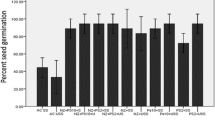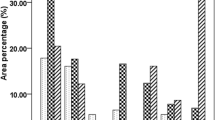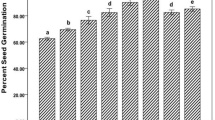Abstract
Bio-inoculants play an important role for sustainable agriculture. Application of nanocompounds in the agriculture sector provides strength and is reported to enhance crop production but the combined effect of nanocompounds and plant growth-promoting rhizobacteria on plants has not been studied much. Therefore, the present study was planned to observe the effect of two plant growth promotory Bacillus spp. along with nanozeolite on maize under field conditions using a randomized block design. Combined treatment of nanozeolite and bio-inoculants promoted plant height, root length, fresh and dry weight of shoot and root, chlorophyll, carotenoids, total sugar, protein and phenol contents in maize significantly over control. Enhanced level of catalase, peroxidase, superoxide dismutase, phenols, alcohols and acid-esters in treated plants over control showed their role in stress management. An increase of 29.80% in maize productivity over control was reported in the combined treatment of Bacillus sp. and nanozeolite. Our results indicate that the application of bio-inoculants with nanozeolite showed a positive response on the health and productivity of maize plants. Hence, these may be used to enhance the productivity of different crops.




Similar content being viewed by others
Abbreviations
- CNPs:
-
Chitosan nanoparticles
- TiO2 :
-
Titanium oxide
- NPs:
-
Nanoparticles
- DMSO:
-
Dimethyl sulfoxide
- SOD:
-
Superoxide dismutase
- BSA:
-
Bovine serum albumin
References
Ainsworth EA, Gillespie KM (2007) Estimation of total phenolic content and other oxidation substrates in plant tissues using Folin-Ciocalteu reagent. Nat Protoc 2:875–877
Aminiyan MM, Hosseini H, Heydariyan A (2018) Microbial communities and their characteristics in a soil amended by nanozeolite and some plant residues: short time in-situ incubation. Eurasian J Soil Sci 7:9–19
Arora S, Sharma P, Kumar S, Nayan R, Khanna PK, Zaidi MGH (2012) Gold-nanoparticle induced enhancement in growth and seed yield of Brassica juncea. Plant Growth Regul 66:303–310
Bradford MM (1976) A rapid and sensitive method for the quantitation of microgram quantities of protein utilizing the principle of protein-dye binding. Anal Biochem 72:248–254
Chakravarty D, Erande MB, Late DJ (2015) Graphene quantum dots as enhanced plant growth regulators: effects on coriander and garlic plants. J Sci Food Agric 95:2772–2778
Chandlee JM, Scandalios JG (1984) Analysis of variants affecting the catalase developmental program in maize scutellum. Theor Appl Genet 69:71–77
Chaudhary P, Sharma A (2019) Response of nanogypsum on the performance of plant growth promotory bacteria recovered from nanocompound infested agriculture field. Environ Ecol 37:363–372
Chavan S, Sarangdhar V, Nadanathangam V (2020) Toxicological effects of TiO2 nanoparticles on plant growth promoting soil bacteria. Emerg Contam 6:87–92
DuBois M, Gilles KA, Hamilton JK, Rebers PA, Smith F (1956) Calorimetric method for determination of sugars and related substances. Anal Chem 28:350–356
Ge Y, Schimel JP, Holden PA (2012) Evidence for negative effects of TiO2 and ZnO nanoparticles on soil bacterial communities. Environ Sci Technol 45:659–1664
Ghervariya KK, Desai PB (2014) Rhizobacteria of sugarcane: in vitro screening for their plant growth -promoting potentials. Res J Recent Sci 3:52–58
Giannopolitis CN, Ries SK (1977) Superoxide dismutases I. Occurrence in higher plants. Plant Physio 59:309–314
Giraldo JP, Landry MP, Faltermeier SM, McNicholas TP, Iverson NM, Boghossian AA, Reuel NF, Hilmer AJ, Sen F, Brew JA, Strano MS (2014) Plant nanobionics approach to augment photosynthesis and biochemical sensing. Nature Mat 13:109–117
Glick BR (2012) Plant growth-promoting bacteria: mechanisms and applications. Hindawi Publishing Corporation, Scientifica, London
Gui X, Rui M, Song Y, Ma Y, Rui Y, Zhang P, He X, Li Y, Zhang Z, Liu L (2017) Phytotoxicity of CeO2 nanoparticles on radish plant (Raphanus sativus). Environ Sci Pollut Res 24:13775–13781
Jia X, Meng Q, Zeng H, Wang W, Yin H (2016) Chitosan oligosaccharide induces resistance to Tobacco mosaic virus in Arabidopsis via the salicylic acid–mediated signalling pathway. Sci Rep 6:26144
Katiyar D, Hemantaranjan A, Singh B (2015) Chitosan as a promising natural compound to enhance potential physiological responses in plant: a review Indian. J Plant Physiol 20:1–9
Khati P, Sharma A, Gangola S, Kumar R, Bhatt P, Kumar G (2017a) Impact of some agriusable nanocompounds on soil microbial activity: an indicator of soil health. Clean-Soil Air Water 45:1600458
Khati P, Chaudhary P, Gangola S, Bhatt P, Sharma A (2017b) Nanochitosan supports growth of Zea mays and also maintains soil health following growth. 3 Biotech 7:81
Khati P, Parul BP, Nisha KR, Sharma A (2018) Effect of nanozeolite and plant growth -promoting rhizobacteria on maize. 3 Biotech 8:141
Khati P, Chaudhary P, Gangola S, Sharma A (2019a) Influence of nanozeolite on plant growth promotory bacterial isolates recovered from nanocompound infested agriculture field. Environ Ecol 37:521–527
Khati P, Sharma A, Chaudhary P, Singh AK, Gangola S, Kumar R (2019b) High- throughput sequencing approach to access the impact of nanozeolite treatment on species richness and evens of soil metagenome. Biocatal Agric Biotechnol 20:101249
Kirk JOT, Allen RL (1965) Dependence of chloroplast pigment synthesis on protein synthesis: effect of actidione. Biochem Biophys Res Commun 21:523–530
Kukreti B, Sharma A, Chaudhary P, Agri U, Maithani D (2020) Influence of nanosilicon dioxide along with bioinoculants on Zea mays and its rhizospheric soil. 3 Biotech 10:345
Kumari S, Sharma A, Chaudhary P, Khati P (2020) Management of plant vigor and soil health using two agriusable nanocompounds and plant growth promotory rhizobacteria in Fenugreek. 3 Biotech 10:461
Latif HH, Ghareib M, Tahon MA (2017) Phytosynthesis of silver nanoparticles using leaf extracts from Ocimum basilicumand Mangifira indicaand their effect on some biochemical attributes of Triticum aestivum. Gesunde Pflanzen 69:39–46
Mali PC, Vyas SP, Satish LL (1989) Biochemical components of clusterbean genotypes in relation to bacterial blight. Indian Phytopathol 42:559–561
Mousavi-Kouhi SM, Lahouti M, Ganjeali A, Entezari MH (2015) Comparative effects of ZnO nanoparticles, ZnO bulk particles, and Zn2þ on Brassica napus after long-term exposure: changes in growth, biochemical compounds, antioxidant enzyme activities, and Zn bioaccumulation. Water Air Soil Poll 226:364
Mukherjee A, Sun Y, Morelius E, Tamez C, Bandyopadhyay S, Niu G, White JC, Peralta-Videa JR, Gardea-Torresdey JL (2016) Differential toxicity of bare and hybrid ZnO nanoparticles in green pea (Pisum sativum L.): a life cycle study. Front Plant Sci 6:1242
Nair P, Varghese SH, Nair BG, Maekawa T, Yoshida Y, Kumar DS (2010) Nanoparticulate material delivery to plants. Plant Sci 9:154–163
Ok CH, Anderson SH, Ervin EH (2003) Amendments and construction systems for improving the performance of sand-based putting greens. Agron J 95:1583–1590
Olczyk T (2005) Vegetarian news letter. Horticultural sciences department: a vegetable crops extension publication. Vegetarian
Ozyigit II, Filiz E, Vatansever R, Kurtoglu KY, Koc I, Öztürk MX, Anjum NA (2016) Identification and comparative analysis of H2O2-scavenging enzymes (ascorbate peroxidase and glutathione peroxidase) in selected plants employing bioinformatics approaches. Front Plant Sci 7:301
Raliya R, Tarafdar JC (2013) ZnO nanoparticle biosynthesis and its effect on phosphorous-mobilizing enzyme secretion and gum contents in Clusterbean (Cyamopsis tetragonoloba L.). Agric Res 2:48–57
Raliya R, Nair R, Chavalmane S, Wang WN, Biswas P (2015) Mechanistic evaluation of translocation and physiological impact of titanium dioxide and zinc oxide nanoparticles on the tomato (Solanum lycopersicum L.) plant. Metallomics 7:1584–1594
Ramesh K, Biswas AK, Somasundaram J, Subba Rao A (2010) Nanoporous zeolites in farming: current status and issues ahead. Curr Sci 99:760–765
Ramesh M, Palanisamy K, Babu K, Sharma NK (2014) Effects of bulk & nano-titanium dioxide and zinc oxide on physio-morphological changes in Triticum aestivum Linn. J Glob Biosci 3:415–422
Rui M, Ma C, White JC, Hao Y, Wang Y, Tang X, Yang J, Jiang F, Ali A, Rui Y, Cao W, Chen G, Xing B (2018) Metal oxide nanoparticles alter peanut (Arachis hypogaea L.) physiological response and reduce nutritional quality: a life cycle study. Environ Sci Nano 5:2088–2102
Soil Survey Staff (2010) Keys to soil taxonomy, 11th edn. USDA-Natural Resources Conservation Service, Washington
Stepanova AN, Yun J, Likhacheva AV, Alonso JM (2007) Multilevel interactions between ethylene and auxin in Arabidopsis roots. Plant Cell 19:2169–2185
Suriyaprabha R, Karunakaran G, Yuvakkumar R, Rajendran V, Kannan N (2012) Silica nanoparticles for increased silica availability in maize (Zea mays L.) seeds under hydroponic conditions. Curr Nanosci 8:902–908
Timmusk S, Seisenbaeva G, Behers L (2018) Titania (TiO2) nanoparticles enhance the performance of growth-promoting rhizobacteria. Sci Rep 8:617
Tripathi DK, Shweta S, Singh S, Pandey R, Singh VP, Sharma NC, Prasad SM, Dubey NK, Chauhan DK (2016) An overview on manufactured nanoparticles in plants: uptake, translocation, accumulation and phytotoxicity. Plant Physiol Biochem 7:1
Tyagi J, Varma A, Pudake RN (2017) Evaluation of comparative effects of arbuscular Mycorrhiza (Rhizophagus intraradices) and endophyte (Piriformospora indica) association with finger millet (Eleusine coracana) under drought stress. Eur J Soil Biol 81:1–10
Urbonaviciute A, Samuoliene G, Sakalauskaite J, Duchovskis P, Brazaityte A, Siksnianiene JB, Ulinskaite R, Sabajeviene G, Baranauskis K (2006) The effect of elevated CO2 concentrations on leaf carbohydrate, chlorophyll contents and photosynthesis in radish. Pol J Environ Stud 15:921–925
Venkatachalam P, Priyanka N, Manikandan K, Ganeshbabu I, Indiraarulselvi P, Geetha N, Muralikrishna K, Bhattacharya RC, Tiwari M, Sharma N, Sahi SV (2017) Enhanced plant growth-promoting role of phycomolecules coated zinc oxide nanoparticles with P supplementation in cotton (Gossypium hirsutum L.). Plant Physiol Biochem 110:118–127
Wang Y, Jiang F, Ma C, Rui Y, Tsang DCW, Xing B (2019) Effect of metal oxide nanoparticles on amino acids in wheat grains (Triticum aestivum) in a life cycle study. J Environ Manage 241:319–327
Yadav V (2013) Nanotechnology, big things from a tiny world: a review. Adv Electr Electron Eng 3:771–778
Zakry FAA, Shamsuddin ZH, Khairuddin AR, Zakaria ZZ, Anuar AR (2012) Inoculation of Bacillus sphaericus UPMB10 to young oil palm and measurement of its uptake of fixed nitrogen using the 15N isotope dilution technique. Microbes Environ 27:257–262
Zhao L (2012) Stress response and tolerance of Zea maysto CeO2 nanoparticles: cross talk among H2O2, heat shock protein, and lipid peroxidation. ACS Nano 6:9615–9622
Zhao LJ, Peralta-Videa JR, Rico CM, Hernandez-Viezcas JA, Sun YP, Niu GH (2014) CeO2 and ZnO nanoparticles change the nutritional qualities of cucumber (Cucumis sativus). J Agric Food Chem 62:2752–2759
Boczkowski J, Hoet P (2009) What’s new in nanotoxicology? Implications for public health from a brief review of the 2008 literature. Nanotoxicology 4:1–14
Siddaiah NC, Prasanth HVK, Satyanarayana RN, Mudili V, Gupta KV, Kalagatur KN, Satyavati T, Dai FX, Chen YJ, Mocan A, Singh PB, Kumar R, Srivastava, (2018) Chitosan nanoparticles having higher degree of acetylation induce resistance against pearl millet downy mildew through nitric oxide generation. Sci Rep 8:2485
Hiscox JD, Israelstam GF (1979) A method for the extraction of chlorophyll from leaf and tissue without maceration. Can J Bot 57:1332–1334
Heinen RB, Ye Q, Chaumont F (2009) Role of aquaporins in leaf physiology. J Exp Bot 11:2971–2985
Khodakovskaya M, Dervishi E, Mahmood M, Xu Y, Li Z, Watanabe F (2009) Carbon nanotubes are able to penetrate plant seed coat and dramatically affect seed germination and plant growth. ACS Nano 3:3221–3227
Mahakham W, Ajit K, Maensiri S, Theerakulpisut P (2017) Nanopriming technology for enhancing germination and starch metabolism of aged rice seeds using phytosynthesized silver nanoparticles. Sci Rep 7:8263
Acknowledgements
Authors gratefully acknowledge the financial support provided by UCB, Haldi, Uttarakhand in a form of a project. Facilities provided by Department of Agronomy and Plant Breeding and Genetics are duly acknowledged.
Author information
Authors and Affiliations
Contributions
PC: experimental design and research work participated in all experiments and wrote the manuscript. PK: isolated and characterized the bacterial culture used in the experiment. AC: helped in data interpretation. SG: participated in analysis of agronomical parameters of maize crop. RK: provided the field facilities and nanozeolite used in the experiment. AS: provided the laboratory facilities and critical checking of the manuscript.
Corresponding author
Ethics declarations
Conflict of interest
Authors declare that they have no conflicts of interests.
Supplementary Information
Below is the link to the electronic supplementary material.
Rights and permissions
About this article
Cite this article
Chaudhary, P., Khati, P., Chaudhary, A. et al. Bioinoculation using indigenous Bacillus spp. improves growth and yield of Zea mays under the influence of nanozeolite. 3 Biotech 11, 11 (2021). https://doi.org/10.1007/s13205-020-02561-2
Received:
Accepted:
Published:
DOI: https://doi.org/10.1007/s13205-020-02561-2




